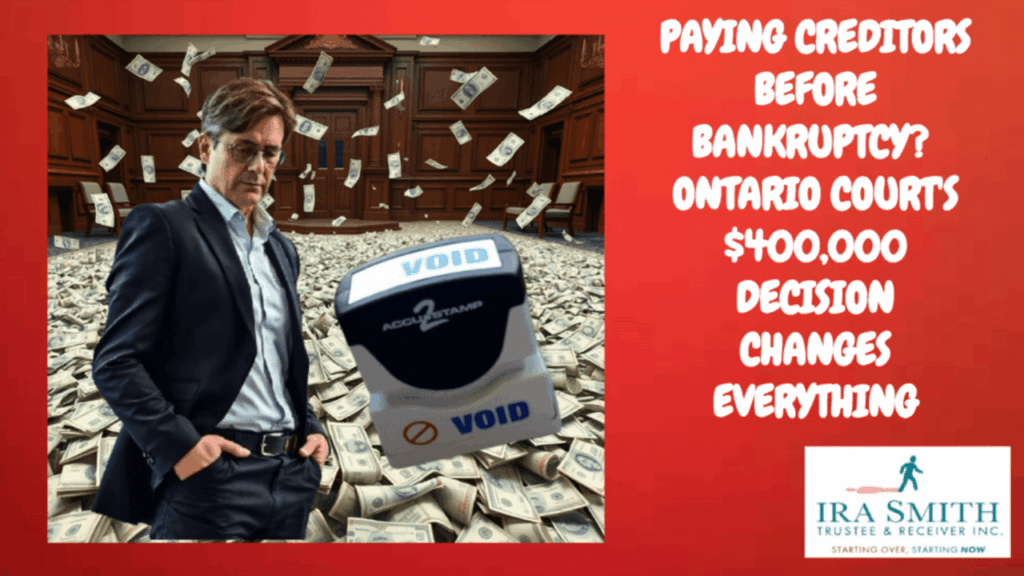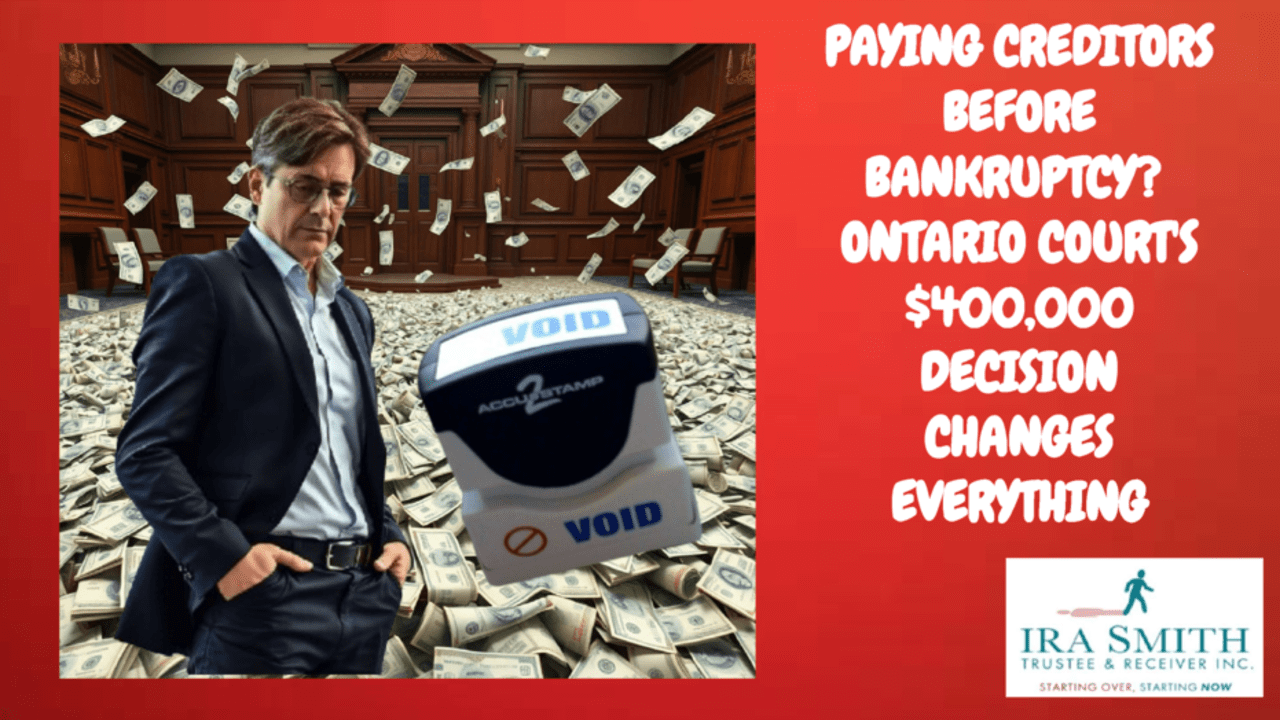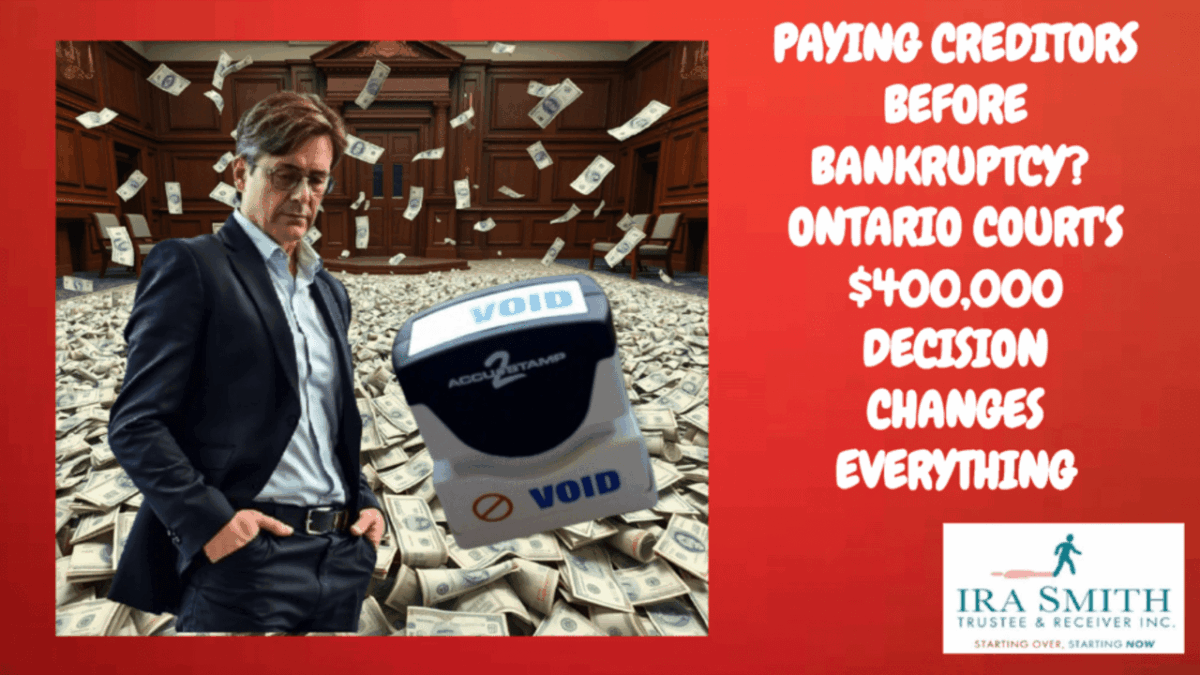Thank you for reading our Brandon's Blog. Check out our AI insolvency bot on this page and don't forget to subscribe!
- A Recent Ontario Court Decision Every Business Owner Should Know About
- What Happened: The $400,000 Payment That Backfired
- Creditor vs. Debtor: What Is a Creditor Preference?
- Why Did Specialty's "Business Survival" Argument Fail?
- What This Means for Your Business
- Key Takeaways
- Protecting Your Business from Preference Issues
- Final Thoughts on Fairness
- Preference FAQ: Your Questions Answered
- Six Key Lessons from the Preference Case
- The Hard Truth About Equality
A Recent Ontario Court Decision Every Business Owner Should Know About
As a Licensed Insolvency Trustee practicing in the Greater Toronto Area, I’ve guided many businesses through difficult financial times. Today, I want to share an important recent court decision showing the legal development of how companies handle creditor payments when facing money troubles.
What Happened: The $400,000 Payment That Backfired
The Court of Appeal for Ontario recently made a big decision in a legal action called RPG Receivables Purchase Group Inc. v. American Pacific Corporation (released May 15, 2025).
Here’s what happened in simple terms:
- A company called Specialty Chemical Industries was struggling financially
- They owed over $11 million to various parties in respect of various secured loans and unsecured creditor suppliers’ unpaid debts
- One supplier, American Pacific Corporation (AmPac), was their main supplier
- Specialty paid AmPac $400,000 to get $100,000 worth of chemicals
- They hoped this would help them fill an order for their main customer
- Less than two months later, Specialty went bankrupt
The court ruled that this $400,000 unsecured debt payment was a “preference” – meaning Specialty unfairly favoured one creditor (AmPac) over all their other creditors. AmPac was ordered to return the money.
Creditor vs. Debtor: What Is a Creditor Preference?
When a business is going under, the law says all creditors should be treated fairly. Section 95 of the Bankruptcy and Insolvency Act (BIA) calls this “creditor equality.”
A preference happens when:
- A debtor pays one creditor shortly before bankruptcy (within 3 months)
- This payment gives the payee better treatment than others
- The debtor knew it couldn’t pay all its debts
The law assumes any payment made within 3 months of bankruptcy was intended to prefer that payee. It’s up to the business to prove otherwise.
Why Did Specialty’s “Business Survival” Argument Fail?
The argument was that Specialty paid AmPac under unsecured credit terms because they needed to keep their business going. It was argued this wasn’t preferring one over others – it was trying to save the company for everyone’s benefit.
The court didn’t buy this argument. Here’s why:
- No solid plan: Specialty had no clear plan showing how this payment would help the company and all stakeholders
- Poor financial position: After the payment, they had only $35,000 left but owed $11 million
- Low profit margins: Their profit margins were only 2-10%, not enough to dig out of debt
- No testimony: No company director testified to explain their plan
- Failed strategy: Their main customer left anyway
FULL DISCLOSURE: My Firm was the licensed insolvency trustee administering the company director’s bankruptcy. The personal bankruptcy occurred by the court issuing a Bankruptcy Order in January 2019, through a legal proceeding initiated by RPG. Both the director and my Firm have since been discharged. My Firm was not involved in this court case I am writing about.
 What This Means for Your Business
What This Means for Your Business
If your business is facing financial problems, this case offers important lessons:
Do:
- Treat all creditors fairly if you’re approaching insolvency
- Document your business plans that show how payments benefit all stakeholders
- Seek professional advice early from a Licensed Insolvency Trustee
Don’t:
- Pay one unsecured party a large sum when you can’t pay others
- Make last-minute payments, hoping to save your business without a solid plan
- Assume “business necessity” justifies preferring one over another
I often see business owners make decisions based on hope rather than reality when facing financial trouble. They think, “If I just pay this one supplier, I can keep going.”
The court’s message is clear: hope isn’t enough. If you can’t prove your plan truly benefits all stakeholders,, not just one, the payment could be considered a preference and later clawed back.
Key Takeaways
- All unsecureds rank equally under bankruptcy law
- Payments made shortly before bankruptcy are carefully scrutinized
- Commercial pressure doesn’t justify preferring one over another
- Only evidence-based rescue plans can justify paying one over others
Protecting Your Business from Preference Issues
As a business owner, you need to understand these rules before financial troubles hit. If you’re struggling to manage all your payments, it’s time to speak with a Licensed Insolvency Trustee about your options.
We can help you develop strategies that comply with the law while giving your business the best chance for recovery, or at least ensure you will not be giving yourself bigger headaches and legal liability if bankruptcy becomes necessary.
Final Thoughts on Fairness
The law may seem harsh, but it serves an important purpose: ensuring everyone is treated fairly when a business fails. Without these rules, stronger or favoured suppliers would get paid while others get nothing.
Remember: when it comes to creditor treatment during financial distress, good intentions aren’t enough. The law demands fairness – even when that’s difficult.
Preference FAQ: Your Questions Answered
What exactly does “anti-preference” mean in bankruptcy law?
The anti-preference rules in the BIA stop businesses from playing favourites when they’re about to go bankrupt. These rules make sure all regular unsecureds are treated fairly and share equally in whatever assets are left. This is the cornerstone of Canadian bankruptcy law – fairness for all stakeholders.
When might a payment to a creditor be considered unfair?
A payment might be considered unfair (or “void”) when:
- It’s made within 3 months before bankruptcy
- It’s made while the business can’t pay all its debts
- It gives that party better treatment than others
If these conditions are met, the court assumes the payment was meant to give special treatment.
What is a “rebuttable presumption” regarding creditor payments?
This legal term simply means the court starts by assuming any payment made to a creditor within 3 months of bankruptcy was intended to favour them. It’s then up to the business to prove this wasn’t their intention. Even if a creditor was putting pressure on the business, that pressure alone isn’t enough to justify the payment.
Can a business explain that they were under pressure from a creditor?
Yes, but with limits. A business can tell the court about pressure put on them to help explain their situation, but pressure alone won’t justify the payment. The court will consider this information as part of the whole picture, not as a valid reason for favouring one over others.
How can a business prove they weren’t trying to favour one creditor?
A business must show that its main goal wasn’t to give one stakeholder special treatment. They need to prove, with clear evidence, that they had a different reason for making the payment, like trying to keep the business going with a solid plan that would benefit all stakeholders in the long run.
When is “trying to save the business” a valid reason for paying just one creditor?
This reason only works if the business had a realistic plan that would help everyone, not just one. Having a vague hope or wish isn’t enough. The business needs to show:
- A sensible business plan
- Evidence that the plan could realistically work
- Proof that the plan would benefit all stakeholders, not just one
- That the financial situation wasn’t already hopeless
Why does a business continuity plan need to be “reasonable”?
The “reasonable plan” requirement ensures businesses don’t drain their remaining assets, helping one or two parties while leaving nothing for everyone else. A reasonable plan aligns with bankruptcy law’s core purpose – fair treatment for all. If a payment is part of a genuine strategy that could improve the situation for everyone, then it isn’t considered unfair to others.
What factors do courts look at when deciding if a business plan was reasonable?
Courts consider several practical factors:
- Was there a clear, sensible business plan?
- Was the business already too far gone financially?
- Did the potential benefits outweigh the payment amount?
- Would a bankruptcy trustee have made the same decision to maximize recovery for all creditors?

Six Key Lessons from the Preference Case
This case teaches us important lessons about how creditors are treated when a business is heading toward bankruptcy. Let’s break down what the Court of Appeal for Ontario said in simple terms:
1. All Creditors Must Be Treated Equally
The court firmly reminded us that the foundation of bankruptcy law is treating all creditors fairly. Section 141 of the BIA states that “all unsecured creditors rank equally and share equally in the bankrupt’s assets.” This isn’t just a nice idea – it’s the law.
2. Payments Shortly Before Bankruptcy Can Be Reversed
When a business pays one creditor right before bankruptcy (within 3 months), that payment can be “voided,” – meaning the creditor has to give the money back. This happens when:
- The business was already unable to pay all its debts
- The payment gave that creditor better treatment than others
In this case, AmPac had to return the entire $400,000 payment.
3. Courts Assume Preferential Intent
If arrangements with creditors, including a payment, check the boxes above, the court starts with the assumption that the business intended to give that creditor special treatment. This is called a “rebuttable presumption,” which means it’s up to the business to prove otherwise.
4. Pressure from a Supplier Isn’t an Excuse
The court clarified an important point: just because a creditor was demanding payment doesn’t justify giving them special treatment. While the court will consider creditor pressure as part of the whole story, it can’t be the main excuse for the payment.
5. Business Continuation Plans Need to Be Realistic
The court established a clear standard: if a business claims they made a payment to stay afloat (not to prefer one creditor), they must show they had a reasonable plan. This plan must:
- Be more than just wishful thinking
- Shows real potential to benefit all creditors, not just one
- Be something a bankruptcy trustee might reasonably do to help all creditors
6. Courts Look at Hard Facts, Not Just Good Intentions
When deciding if a business plan was reasonable, courts look at practical factors:
- Was there a sensible, detailed business plan?
- Was the business already beyond saving?
- Did the potential benefits outweigh the payment amount?
- Would the plan help satisfy all creditor claims?
The Hard Truth About Equality
The outcome of this case might seem harsh. AmPac provided goods, Specialty made a payment, and now AmPac has to give the money back. But bankruptcy law has a greater purpose – making sure one creditor doesn’t get special treatment while others get nothing.
In the end, the court ordered AmPac to return the entire $400,000. This reinforces an important principle: when a business is heading toward bankruptcy, fairness to all creditors matters more than the survival of one relationship.
For business owners, the message is clear: when you’re facing financial trouble, you can’t play favourites with creditors – even if it feels like the only way to keep your business alive. The law demands fairness, even when fairness is difficult.
As a licensed insolvency trustee serving the Greater Toronto Area, I encourage business owners to view financial difficulties not as failures but as challenges that can be addressed with proper guidance. By understanding the warning signs of company insolvency and seeking professional advice early, many businesses can find a path forward – whether through restructuring, strategic changes, or in some cases, an orderly wind-down that protects their future opportunities.
Remember: The earlier you seek help for company insolvency concerns, the more options you’ll have.
If you or someone you know is struggling with too much debt, remember that the financial restructuring process, while complex, offers viable solutions with the right guidance. As a licensed insolvency trustee serving the Greater Toronto Area, I help entrepreneurs understand their options and find a path forward during financial challenges.
At the Ira Smith Team, we understand the financial and emotional components of debt struggles. We’ve seen how traditional approaches often fall short in today’s economic environment, so we focus on modern debt relief options that can help you avoid bankruptcy while still achieving financial freedom.
The stress of financial challenges can be overwhelming. We take the time to understand your unique situation and develop customized strategies that address both your financial needs and emotional well-being. There’s no “one-size-fits-all” approach here—your financial solution should be as unique as the challenges you’re facing.
If any of this sounds familiar and you’re serious about finding a solution, reach out to the Ira Smith Trustee & Receiver Inc. team today for a free consultation. We’re committed to helping you or your company get back on the road to healthy, stress-free operations and recover from financial difficulties. Starting Over, Starting Now.
The information provided in this blog is intended for educational purposes only. It is not intended to constitute legal, financial, or professional advice. Readers are encouraged to seek professional advice regarding their specific situations. The content should not be relied upon as a substitute for professional guidance or consultation. The author, Ira Smith Trustee & Receiver Inc., and any contributors do not assume any liability for any loss or damage.

